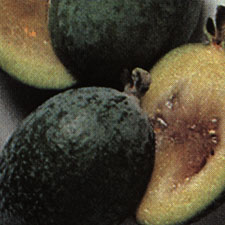
FoodFood InformationFruitTropical
Better known to back-yard gardeners as the pineapple guava, the
gray-green, egg-shaped feijoa is native to South America. Feijoas have recently
enjoyed great commercial popularity in New Zealand; they've also been planted
in some quantity in California.
Commercial feijoa varieties are uniformly 2 1/2 to 3 inches long (garden
varieties are usually smaller). Their pale yellow flesh is very sweet, aromatic,
and juicy, not unlike that of the common guava. Some describe the flavor
as a cross between pineapple and banana. Tiny seeds in the soft inner pulp
are edible. The thick, waxy skin is too tart to eat fresh, but it can be
used in pickles or preserves.
A good source of vitamin C, feijoas have about 35 calories per 3 1/2 ounce
serving. Fruits sold in markets are usually very firm and bright olive
green. When ripe, the fruit become soft as a ripe plum and they turn dark
green; the aroma is pronounced. Ripen fruit at room temperature, uncovered,
out of direct sun; turn frequently. Refrigerate ripe fruit, uncovered, in
a single layer on paper-towel lined trays for up 2 days, don't freeze.
To eat fresh, cut feijoas in half and scoop flesh from shell with a spoon.
To slice, peel fruit with a sharp knife, then cut crosswise into thin slices.
Feijoas darken quickly when cut; to preserve their color, cut surfaces with
lemon or lime juice (Eight to 10 feijoas yield 1 cup pulp).
For breakfast, offer feijoa halves ready to eat from the shell, or serve
slices with pancakes waffles, or sweet omelets. Slices also good in fruit
salads, especially those containing oranges. For dessert
drizzle slices with orange-flavored liqueur and serve with vanilla ice cream
or with orange or lemon sherbet or sorbet. Since have the same aromatic,
tropical and soft texture as guavas do, you can substitute them for guavas
in guava recipes.
Sauteeing: Peel feijoas, then a in halves lengthwise and coat w lemon juice.
Saute tender when pierced (about 4 min)
Sporadically avialable from late February through early June for New Zealand
fruit; early September through December for California feijoas.

Deamer 5/97